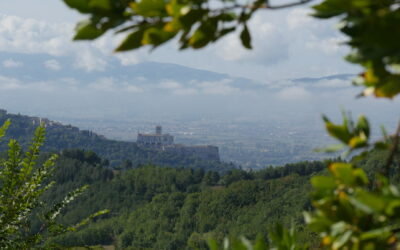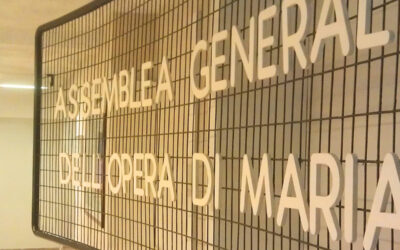 “In explaining the meaning of the spirituality of unity to the Bishops of the Focolari Movement during their meeting on 10 February 1984, Chiara Lubich made a few remarks: “It is a journey undertaken together, in which we strive to help the others to reach sanctity in the same way as we try to sanctify ourselves, since what matters before all else, is to glorify God. And what gives a decisive impulse to the personal effort to reach sanctity is Christ’s presence in an increasingly intense manner among Christians which affects each person in an ever deeper way.” And here, once again, Chiara Lubich underpinned the novelty of this type of sanctity and pathway: the term, “An interior castle,” in the same way as St. Teresa called the reality of the soul inhabited by His Majesty, is a very suitable term which we have to discover and highlight. It is the height of sanctity in an individual path. However, the time has come to discover, enlighten, and edify for God, also his exterior castle, so to say, with His presence among us. This – on a deeper reflection – is nothing else but the fact that the Church in which we live, through this spirituality, can more and more fulfill this calling, and grow in beauty and splendour as the mystical spouse of Christ, the foretaste of the Heavenly Jerusalem, which was described in the words: “Behold! The dwelling place of God is with man! And He will dwell with them and they will be his people and God himself will be with them as their God.” (Revelation 21,3). […] When visiting Spain in the first days of December 2003, Chiara wanted to go to Avila, St Theresa’s birthplace, to visit the monastery of the Incarnation where Teresa had lived for more than 27 years […] She signed the monastery’s Golden Book with this testimonial of her “spiritual friendship” with the Saint of Avila: “Thank you, St. Teresa, for all you have done for us, for our journey. Thanks! But we will express our deepest thanks to you in Paradise. Continue to watch over all of us, over “our exterior castle” which the divine Spouse established on earth, as a completion of your “interior castle,” to embellish the Church as you desired. See you soon, St. Teresa. A big hug, Chiara.” I have always considered Teresa of Avila’s interior castle as a proposed evangelical lifestyle for all Christians who wish to live their own universal vocation of sanctity, union with God in the Trinitarian and ecclesiastic experience. But what I consider the even bigger grace, and more exciting adventure, is that of participating with the charisma of unity, in the discovery of this particular design of God, the possibility to live together the adventure of community and ecclesiastic sanctity, in building a splendid, shining exterior castle, personified in the Work of Mary, for the Church and humanity.” Further reading: “Two women and two castles” Excerpt from “The exterior castle, the novelty of the spirituality of Chiara Lubich,” (“Il castello esteriore, il nuovo nella spiritualità di Chiara Lubich”), by Jesús Castellano Cervera (1941-2006), pp. 63-67/68.
“In explaining the meaning of the spirituality of unity to the Bishops of the Focolari Movement during their meeting on 10 February 1984, Chiara Lubich made a few remarks: “It is a journey undertaken together, in which we strive to help the others to reach sanctity in the same way as we try to sanctify ourselves, since what matters before all else, is to glorify God. And what gives a decisive impulse to the personal effort to reach sanctity is Christ’s presence in an increasingly intense manner among Christians which affects each person in an ever deeper way.” And here, once again, Chiara Lubich underpinned the novelty of this type of sanctity and pathway: the term, “An interior castle,” in the same way as St. Teresa called the reality of the soul inhabited by His Majesty, is a very suitable term which we have to discover and highlight. It is the height of sanctity in an individual path. However, the time has come to discover, enlighten, and edify for God, also his exterior castle, so to say, with His presence among us. This – on a deeper reflection – is nothing else but the fact that the Church in which we live, through this spirituality, can more and more fulfill this calling, and grow in beauty and splendour as the mystical spouse of Christ, the foretaste of the Heavenly Jerusalem, which was described in the words: “Behold! The dwelling place of God is with man! And He will dwell with them and they will be his people and God himself will be with them as their God.” (Revelation 21,3). […] When visiting Spain in the first days of December 2003, Chiara wanted to go to Avila, St Theresa’s birthplace, to visit the monastery of the Incarnation where Teresa had lived for more than 27 years […] She signed the monastery’s Golden Book with this testimonial of her “spiritual friendship” with the Saint of Avila: “Thank you, St. Teresa, for all you have done for us, for our journey. Thanks! But we will express our deepest thanks to you in Paradise. Continue to watch over all of us, over “our exterior castle” which the divine Spouse established on earth, as a completion of your “interior castle,” to embellish the Church as you desired. See you soon, St. Teresa. A big hug, Chiara.” I have always considered Teresa of Avila’s interior castle as a proposed evangelical lifestyle for all Christians who wish to live their own universal vocation of sanctity, union with God in the Trinitarian and ecclesiastic experience. But what I consider the even bigger grace, and more exciting adventure, is that of participating with the charisma of unity, in the discovery of this particular design of God, the possibility to live together the adventure of community and ecclesiastic sanctity, in building a splendid, shining exterior castle, personified in the Work of Mary, for the Church and humanity.” Further reading: “Two women and two castles” Excerpt from “The exterior castle, the novelty of the spirituality of Chiara Lubich,” (“Il castello esteriore, il nuovo nella spiritualità di Chiara Lubich”), by Jesús Castellano Cervera (1941-2006), pp. 63-67/68.
Take a sense of family everywhere
Take a sense of family everywhere




0 Comments